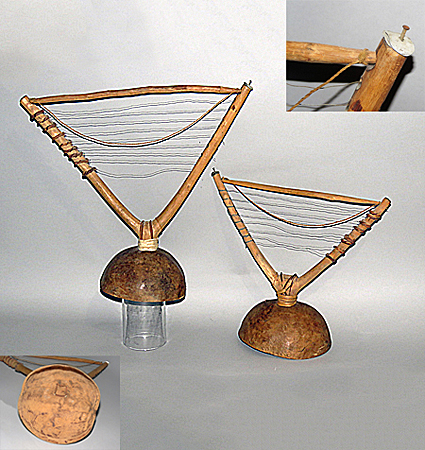Owner: HWMC
Catalog#: 2AF-CHHP-17 & 18
Provenance: Liz Stigall, the niece of Helen Rensch, who in her honor, generously donated these two rare Kru harps collected by her aunt. Liz also provided as validating documentation a published newspaper article and a copy of Helen’s letters to her parents as she ventured to support the Kru people of Sukromo, Liberia.

Harps
Kru Harps 'Kani' from Zorzei
Zorzei, Liberia
Kru People
Calabash, Vegetable Fiber, Wood, Leather ties, Wire Strings (very thin)
ca. Mid-20th Century
Kru Kani A – Height: 15.5 in (10 strings)
Kru Kani B – Height: 11.5 in (8 strings)
Chordophone – Harp – Plucked
Today, the Kru harp, called kani, is considered extinct in the field. It is very rare and believed to have never been seen with any traders. The kani was made from a fork-shaped piece of tree branch that served as a form that is mounted/lashed onto a half gourd. The strings are plucked, and it is played with the open end of the gourd held against the chest to serve as a resonator. Each of these two kani shows metal discs attached at the top of one of the arms, indicating they were used for traditional celebrations and special occasions. The smaller kani supports eight metal strings with leather ties and the larger kani supports ten strings, while nine are still present.
These two Kru harps from Liberia come from teacher Helen Rensch, of Ottawa, Kansas. In 1964, Miss Rensch had volunteered through the Crossroads program (similar to the Peace Corps) to spend her summer in the village of Sukromo, Liberia. That’s five miles from Zorzor, which is 180 miles by dusty road and six hours northeast of Monrovia, the capital of Liberia.
Liberia had asked Crossroads to build a three-room with porch maternity clinic. There were minimal building tools, and the bricks had to be handmade. Miss Rensch began digging the excavation by sharing a shovel and scooping up dirt and rocks with her bare hands. She even mastered carrying a bucket of hand-made bricks on her head. During her seven-week stay, besides working to build the clinic, she taught geography to the third graders, who were quick to learn the English language, while the adults resorted to a type of sign language. As a teacher she also learned about the myths shared by the Liberian Kru children. Her perspective is commendable when she was quoted, “I don’t like to call those people primitive. I just say they have another culture.” During her final week of stay and in appreciation for her commitment to helping the Kru people of Liberia, she was in the town of Zorzei when the brother of the chief of Zorzei presented her with the larger 10 string kani seen here.
